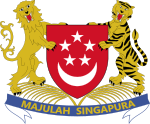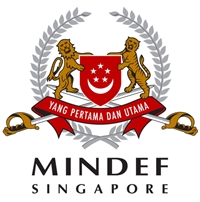 |
|---|
| This article is part of a series on the politics and government of Singapore |
| Constitution |
| Foreign relations |
Related topics |
A Group Representation Constituency (GRC) is a type of electoral division or constituency in Singapore in which teams of candidates, instead of individual candidates, compete to be elected into Parliament as the Members of Parliament (MPs) for the constituency. The Government stated that the GRC scheme was primarily implemented to enshrine minority representation in Parliament: at least one of the MPs in a GRC must be a member of the Malay, Indian or another minority community of Singapore. In addition, it was economical for town councils, which manage public housing estates, to handle larger constituencies.

Constituencies in Singapore are electoral divisions which may be represented by single or multiple seats in the Parliament of Singapore. Constituencies are classified as either Single Member Constituencies (SMCs) or Group Representation Constituencies (GRCs). SMCs are single-seat constituencies but GRCs have between four and six seats in Parliament.

Singapore, officially the Republic of Singapore, is an island city-state in Southeast Asia. It lies one degree north of the equator, at the southern tip of the Malay Peninsula, with Indonesia's Riau Islands to the south and Peninsular Malaysia to the north. Singapore's territory consists of one main island along with 62 other islets. Since independence, extensive land reclamation has increased its total size by 23%. The country is known for its transition from a developing to a developed one in a single generation under the leadership of its founder Lee Kuan Yew.

The Parliament of the Republic of Singapore and the President jointly make up the legislature of Singapore, which is based on the Westminster system. Parliament is unicameral and is made up of Members of Parliament (MPs) who are elected, as well as Non-constituency Members of Parliament (NCMPs) and Nominated Members of Parliament (NMPs) who are appointed. Following the 2015 general election, 89 MPs and three NCMPs were elected to the 13th Parliament. Nine NMPs were appointed during the first session of this Parliament. The first sitting of the 13th Parliament took place on 15 January 2016.
Contents
- Introduction of the scheme
- Operation
- Number and boundaries of electoral divisions
- Requirements of GRCs
- Modifications
- Assessment
- Advantages
- Criticisms of the scheme
- See also
- Notes
- References
- Legislation
- Other works
- Further reading
- Articles and websites
- Books
- External links
The GRC scheme came into effect on 1 June 1988. Prior to that date, all constituencies were Single Member Constituencies (SMCs). Now, the Parliamentary Elections Act (Cap. 218, 2008 Rev. Ed.) ("PEA") states that there must be at least eight SMCs, and the number of MPs to be returned by all GRCs cannot be less than a quarter of the total number of MPs. Within those parameters the total number of SMCs and GRCs in Singapore and their boundaries are not fixed but are decided by the Cabinet, taking into consideration the recommendations of the Electoral Boundaries Review Committee.

The Cabinet of Singapore forms the Government of Singapore together with the President of Singapore. It is led by the Prime Minister of Singapore who is the head of government. The Prime Minister is a Member of Parliament (MP) appointed by the President who selects a person that in his or her view is likely to command the confidence of a majority of the Parliament of Singapore. The other members of the Cabinet are Ministers who are Members of Parliament appointed by the President on the Prime Minister's advice. Cabinet members are prohibited from holding any office of profit and from actively engaging in any commercial enterprise.
According to the Constitution and the PEA, there must be between three and six MPs in a GRC. The precise number of MPs in each GRC is declared by the President at the Cabinet's direction prior to a general election. For the purposes of the 2015 general election, there were 13 SMCs and 16 GRCs, and each GRC had between four and six MPs.

The Constitution of the Republic of Singapore is the supreme law of Singapore. A written constitution, the text which took effect on 9 August 1965 is derived from the Constitution of the State of Singapore 1963, provisions of the Federal Constitution of Malaysia made applicable to Singapore by the Republic of Singapore Independence Act 1965, and the Republic of Singapore Independence Act itself. The text of the Constitution is one of the legally binding sources of constitutional law in Singapore, the others being judicial interpretations of the Constitution, and certain other statutes. Non-binding sources are influences on constitutional law such as soft law, constitutional conventions, and public international law.

The President of the Republic of Singapore is the country's head of state. Singapore has a parliamentary system of government. Executive authority is exercised by the Cabinet led by the Prime Minister of Singapore. The current president is Halimah Yacob, who was elected unopposed at the 2017 presidential election. She is the first female President of Singapore and first Malay head of state in 47 years since the death of Yusof Bin Ishak, Singapore's first president.
Critics disagree with the government's justifications for introducing the GRC scheme, noting that the proportion of minority MPs per GRC has decreased with the advent of five-member and six-member GRCs. By having teams of candidates standing for election for GRCs helmed by senior politicians, the ruling People's Action Party has also used GRCs as a means for bringing first-time candidates into Parliament. Moreover, the GRC scheme is also said to disadvantage opposition parties because it is more difficult for them to find enough candidates to contest GRCs. Furthermore, it is said that the GRC scheme means that electors have unequal voting power, weakens the relationship between electors and MPs, and entrenches racialism in Singapore politics.

The People's Action Party is a major centre-right political party in Singapore. It was founded in 1954 as a pro-independence political party descended from an earlier student organization. It has gone on to dominate the political system of the nation.

The politics of Singapore takes the form of a parliamentary representative democratic republic whereby the President of Singapore is the head of state, the Prime Minister of Singapore is the head of government, and of a multi-party system. Executive power is exercised by the cabinet from the parliament, and to a lesser extent, the President. Cabinet has the general direction and control of the Government and is accountable to Parliament. There are three separate branches of government: the legislature, executive and judiciary abiding by the Westminster system.














